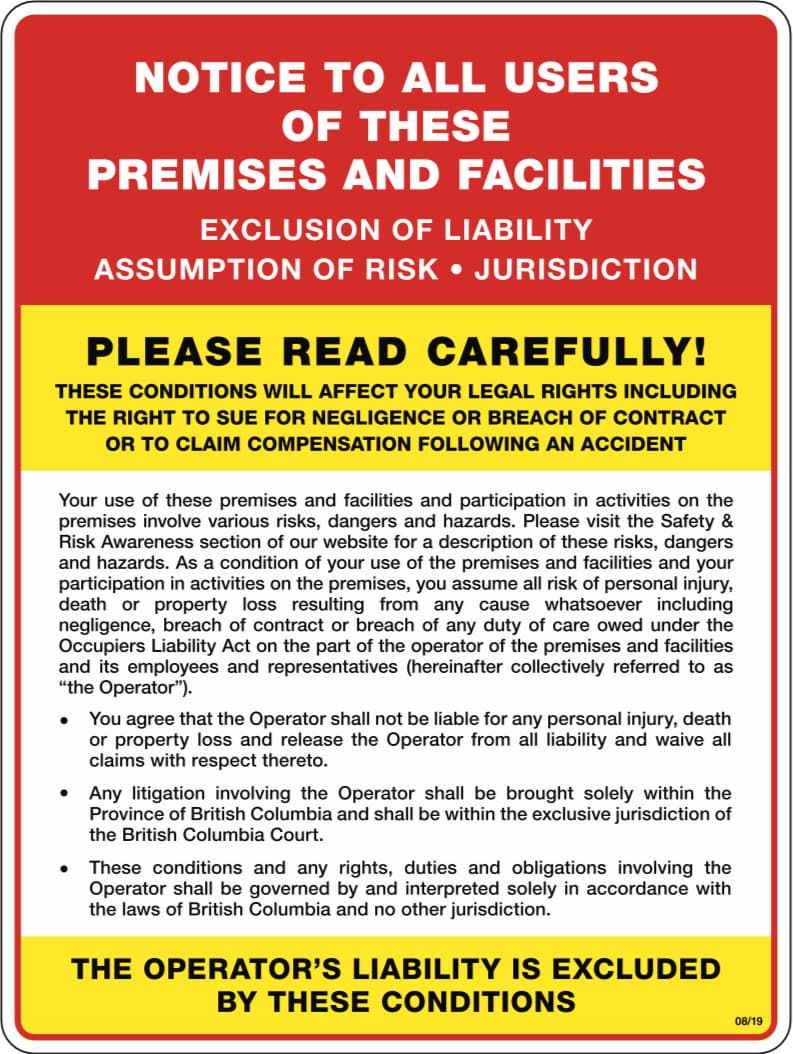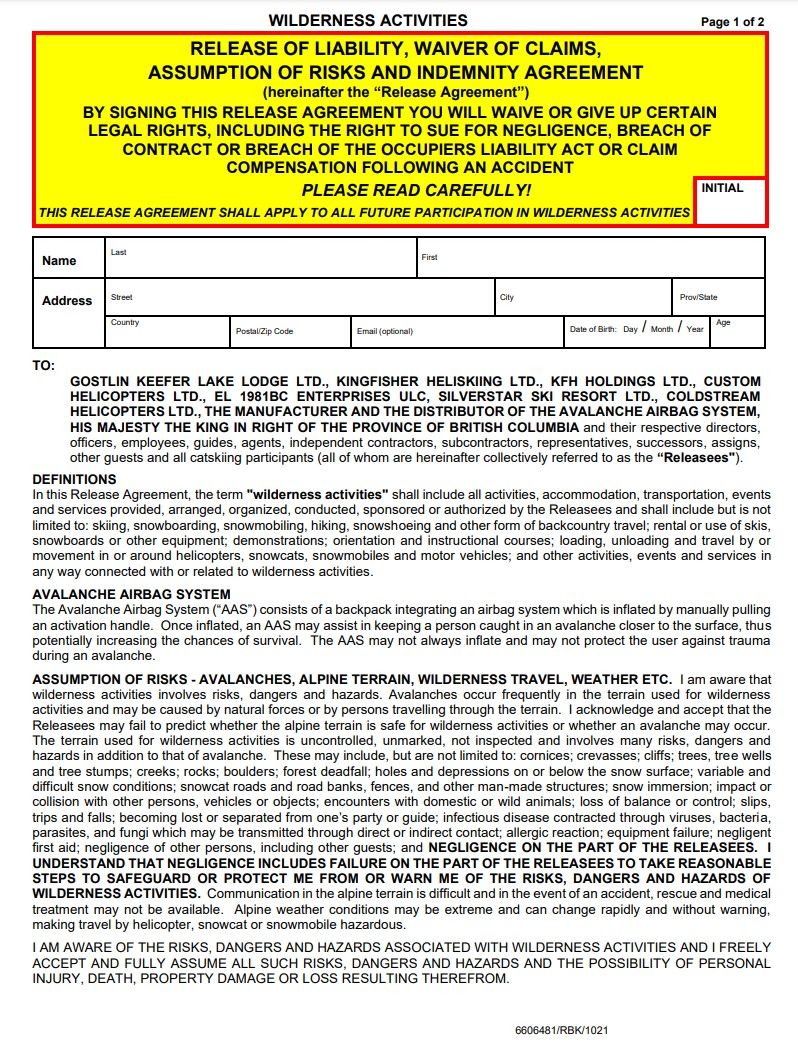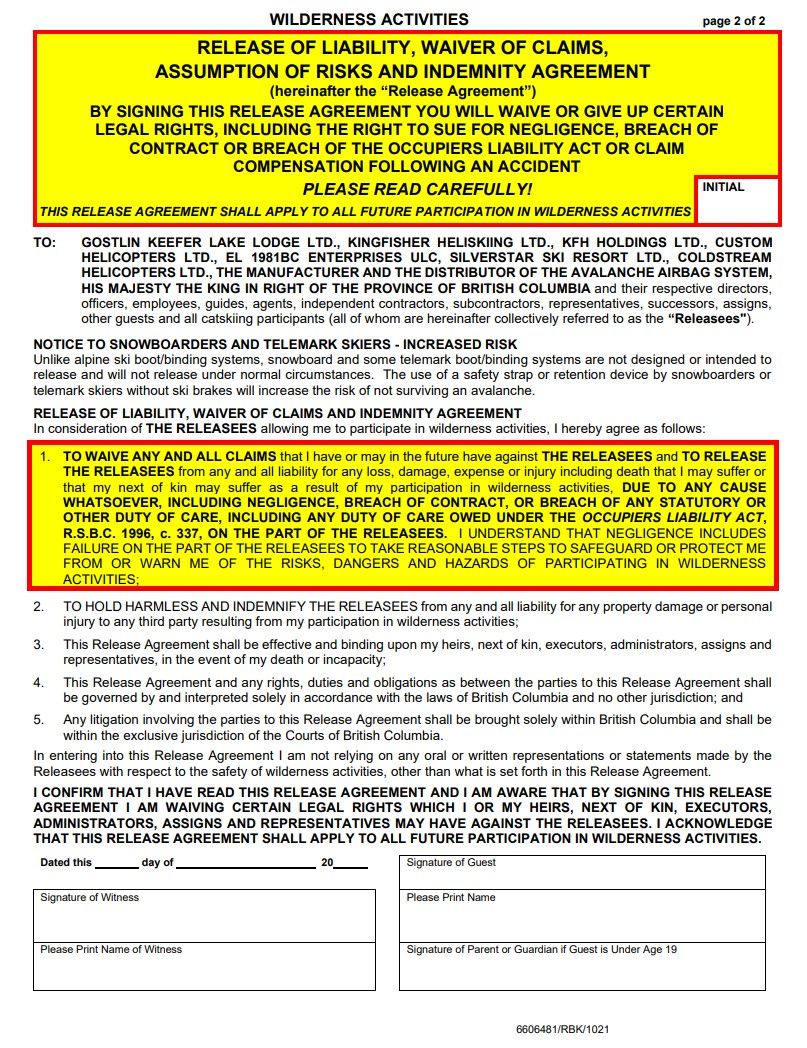Safety & Awareness
Exclusion of Liability – Assumption of Risk
Introduction to Wilderness Skiing and Snowboarding
The term "wilderness skiing and snowboarding" shall include all activities, accommodation, transportation, events and services provided, arranged, organized, conducted, sponsored or authorized by the operator and shall include, but is not limited to: skiing, snowboarding, snowmobiling, hiking, snowshoeing and other form of backcountry travel; rental or use of skis, snowboards or other equipment; demonstrations; orientational and instructional courses; loading, unloading and travel by or movement in or around helicopters, snowcats, snowmobiles and other motorized vehicles; and other activities, events and services in any way connected with or related to wilderness activities.
The use of helicopter or snowcat skiing premises and facilities, and participation in these activities, involves various risks, dangers and hazards. It is a condition of your use of the premises and facilities and your participation in helicopter or snowcat skiing or snowboarding that you assume all risk of personal injury, death or property loss resulting from any cause whatsoever, including negligence, breach of contract, or breach of any duty of care on the part of the operator. Your legal responsibility as a user of the premises and facilities or participant in activities provided by the operator is explained in the following notice, which you will see posted on the premises.

Wilderness Skiing and Snowboarding
- Avalanches occur frequently in the terrain used for wilderness activities and may be caused by natural forces or by persons travelling through the terrain.
- The operator may fail to predict whether the alpine terrain is safe for wilderness activities or whether an avalanche may occur.
- The terrain used for wilderness activities is uncontrolled, unmarked, not inspected and involves many risks, dangers and hazards in addition to that of avalanche. These may include, but are not limited to: cornices; crevasses; cliffs; trees, tree wells and tree stumps; creeks; rocks; boulders; forest deadfall; holes and depressions on or below the snow surface; cliffs; variable and difficult snow conditions; snowcat roads, snowmobile tracks, and road banks, fences, and other man-made structures; snow immersion; impact or collision with other persons, vehicles or objects; encounters with domestic or wild animals; loss of balance or control; slips, trips and falls; becoming lost or separated from one’s party or guide; negligent first aid; negligence of other persons, including other guests; and NEGLIGENCE ON THE PART OF THE OPERATOR.
- Negligence of other persons, and NEGLIGENCE ON THE PART OF THE OPERATOR and its directors, officers, employees, instructors, agents, representatives, volunteers, independent contractors, subcontractors, sponsors, successors and assigns.
- NEGLIGENCE INCLUDES FAILURE ON THE PART OF THE OPERATOR TO TAKE REASONABLE STEPS TO SAFEGUARD OR PROTECT GUESTS FROM THE RISKS, DANGERS AND HAZARDS OF WILDERNESS ACTIVITIES.
- Communication in the alpine terrain is difficult and in the event of an accident, rescue and medical treatment may not be available.
- Alpine weather conditions may be extreme and can change rapidly and without warning, making travel by helicopter, snowcat or snowmobile hazardous.
Alpine Ski/Snowboard Boot Binding Systems
The snowboard boot/binding system is not designed or intended to release and will not release under normal circumstances. Given the snowboard boot binding system is not a releasable system, it will not reduce the risk of injury during a fall and will increase the risk of not surviving an avalanche.
Helmets
Airbag Use
Notice to Snowboarders and Telemark Skiers – Increased Risk
Adventure Film Activities
Wilderness Activities Release Agreement
This is a copy of the Wilderness Activities Release Agreement you will be asked to sign:


Wilderness Skiing and Snowboarding Responsibility Code
- Listen to and follow your guide’s instructions.
- Always stop above your guide.
- Ski and snowboard close to other tracks set by your group.
- Always keep spacing between each skier and rider as directed by your guide.
- On tree runs always ski and snowboard with a partner, remove pole straps and be aware of tree
hazards. - Always ski and snowboard in control and be aware of mountain hazards.
- Approach and join a waiting/stopped group slowly and cautiously.
- Electronics: turn off cell phone reception and don’t impair hearing with music devices.
- Never ski or snowboard up to helicopter; always approach it on foot behind your guide.
- Never walk to the rear of a helicopter and always keep yourselves and your equipment low.
- Maintain the designated position as a helicopter arrives and departs.
- Familiarize yourself avalanche rescue gear: transceiver, shovel, probe and radio.
- Always have a skiing and snowboarding partner. Ski close enough to them that you will
immediately know if they fall into a tree well or get caught in an avalanche. - You must not participate in wilderness skiing or snowboarding if your ability is impaired through
the use of alcohol or drugs.
Also, be aware of the Cross Country Responsibility Code and Mountain Bike Responsibility Code .
Helicopter and Snowcat Safety
While wilderness skiing, skiers and snowboarders may use a variety of transportation methods such as helicopters, snowcats, and snowmobiles. Users should be familiar with the use of these transportation methods for their own safety and the safety of others. Guides, drivers and pilots will provide safety briefings that inform users about the process for loading, riding, and unloading. Pay attention and obey these briefings. If you are unfamiliar with helicopters, snowcats, or snowmobiles, or have questions, please ask your guide for assistance and direction.
Additional Safety Tips
Weather
- Plan ahead for variations in weather. Dress appropriately and have properly tuned gear. Warmth and visibility are key safety components.
- UV rays are reflected from the snow surface. Always wear sunscreen and goggles or sunglasses, even on cloudy days.
- Cold temperatures increase the likelihood of frostbite. Dress warm, bring extra layers and keep an eye on exposed skin. Go inside immediately if skin begins to turn white.
- Take note of the conditions. When the snow surface is hard and fast, it is easy to ski/ride at high speed, increasing the risk for serious injury if you fall and slide. Be aware of changing snow surface conditions.
Tree Wells
- A tree well is the space around a tree under its branches that does not get the same amount of snow as the surrounding open space. This creates a void or area of loose snow below the branches and around the tree trunk that is dangerous to skiers and snowboarders.
- If someone lands in a tree well, it is often headfirst, which can leave them injured or unconscious, or they may suffocate.
- When a victim falls into a tree well, their head and arms will likely be heading down into the hole and their skis or snowboard will be above them. Loose snow will start to fall in around the victim as they move, packing them in against the tree. They will be upside down in the tree well.
- The biggest threat from falling in tree wells is suffocation from the snow packing in around the victim. Another threat can be from hitting the tree and getting injured.
- If you fall into a tree well, don’t panic. Rapid movement and struggling will worsen the situation. It is important to stay still and save energy. You are not likely to get yourself out and will require assistance from others.
- Grab whatever part of the tree you can or hug the tree trunk. Grab tree branches or other parts of the tree to try to stabilize yourself and stop yourself from falling deeper. Hold on tight. Look for air pockets to push your head into. Breathe. Be aware that every movement, however slight, will cause more snow to pack in around you. Do not shake the tree. Create air holes and wait for rescue.
- To prevent falling into tree wells, ski well clear of trees when skiing deep powder. Falling into a tree well is preventable simply by staying away from trees in deep powder.
- To be rescued quickly, ski close to, but beside a buddy. A buddy skiing who is below you on the slope may not know that you fell into a tree well and will have difficulty getting uphill to find and rescue you.
- Be particularly cautious when skiing/riding in the trees. Tree wells are a real risk.
-
If your ski buddy falls into a tree well, you must respond as quickly as possible to rescue them.
- Call out to other skiers in your group to notify them. If you have a whistle, blow it to attract attention.
- Go to the tree well location. Three rescuers are an ideal number of rescuers, so if you are by yourself you may only be able to stabilize the situation until other help arrives.
- In some simple situations, you may be able to pull the skier out of the tree well; in other situations, they will be too far down for this to be successful. Grasp the bottom hem of the victim’s jacket and carefully pull the victim. At the very least, hold the skier from sliding further into the tree well.
- In some cases, a receiving platform or trench may need to be dug below the victim to be able to pull them out of the tree well. Successful tree well rescue is a combination of digging, platform preparation, and pulling.
- Ensure the skier’s airway is clear of snow and that there is an air pocket around their head for them to breathe. Don’t shake the tree or push additional snow into the tree well.
- If the skier is conscious, reassure them and tell them to remain still and calm.
- Remove ski or snowboard equipment from the victim if it is safe to do so.
- When the victim is out of the tree well, assess their condition and apply first aid as required.
See more on tree well safety at www.deepsnowsafety.org and the Tree Well Rescue Best Practices bulletin.
Helmets – it is strongly recommended to wear helmets for skiing and riding. Skiers and snowboarders are encouraged to educate themselves on the benefits and limitations of helmet usage. See more on snow sport helmets at http://www.myhelmet.ca/ .
Avalanches – Take an avalanche course. Learn more about avalanches through Avalanche Canada at https://www.avalanche.ca/ .
Don’t overdo it. Be aware of fatigue; many visitors are on vacation and might not be conditioned to ski/ride long days. Warm up in the morning and stretch it out, then tone it down in the afternoon. Stay hydrated and carry a snack with you to keep you fueled.
BE AWARE OF YOUR SURROUNDINGS.
- Be mindful of where you stop on the slope, for your safety and the safety of other skiers and snowboarders. When resting, move over to the side of the run. Never stop under a roller, jump, cat track, or on a blind corner, as skiers uphill from you will not be able to see you.
- When skiing and snowboarding, be aware of other skiers and snowboarders. Look uphill before you commence downhill, and yield to other skiers and snowboarders.
-
If in doubt, ask your guide.
Ski Operator Premises
Slipping and falling at helicat ski areas has potential for serious injuries and should not be overlooked as a risk. There are many wet, snowy, icy, and slippery surfaces throughout a given facility. Slips, trips and falls are common, and all users should always take precautions. Ski boots and many types of other footwear do not provide good traction, and extra caution should be used when walking. Be particularly careful of slips and falls on snowy or icy surfaces if you have consumed alcohol.
